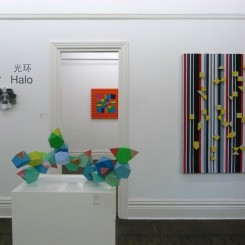All of this sounds like one of those performance art pieces that have permeated the art world. It could be any number of things — a joke, a game, a declaration, a challenge, any or all of the above. This anonymity is certainly an element of ZAKA’s works. While we examine the colorful abstract pieces mounted on the gallery wall, we can’t help but wonder about the anonymous creator hiding behind. In some works, an amalgamation of lines transitioning from light yellow to green is laid on a color block background. In others, colorful three-dimensional shapes are imbedded directly into the densely painted textile background. The colors become the artist’s camouflage, who lurks leopard-like in the jungle. Secure in his hideout, ZAKA observes the social experiment that he himself directs — and one could even imagine him sneaking gleefully into his own opening as an observer. Watching the confusion and eavesdropping on the speculations about his identity, the prankster is probably trying to keep a straight face all the while maintaining a low profile.
What painting opens up is a window to the world. For the artist, painting could be something like the windowsill from which he observes the world. Whether looking inward or outward, his work gathers and reproduces his knowledge, experiences, and emotions. In today’s society, as art crosses ever more boundaries and extends into different areas of knowledge, the weight of experience borne by art will surpass the experiences of a single artist and take on universal significance. This is why theorists like Roland Barthes have questioned the artist’s domination of the dialogue and shattered the myth of the artist as lone genius. The “death” in Barthes’s essay “The Death of the Author” speaks to the diminishing of the artist’s identity when faced with the multitude of other influences affecting a work of art — including the individual interpretative powers and a sense of participation on the part of the viewers.
Works of art embody the context of the times and the attitudes of their society. What then is the attitude ZAKA embodies by choosing anonymity? We could view it as a rebellion against an art market that places more and more importance on an artist’s name; or as an experiment on fame that asks the questions: Can an anonymous artist carve out a place for himself in an art market enamored with commercial trends? Do collectors and critics look at an artist’s work or are they blinded by the artist’s bright aura of fame? ZAKA’s rebellion is obviously calculated, from his first missive to his continued anonymity. Following his own game rules, he seems to be seeking to shift the conversation from outside the picture frame to the work itself. The results have been precisely the reverse, yet ZAKA must have predicted this as well. When the hype surrounding the artist’s anonymity becomes a distracting gimmick, will ZAKA secretly applaud his own efforts?
ZAKA’s first solo exhibition “Halo” presents colorful pieces with lively, playful lines that somehow abide by their own pattern of logic — and the curator has seen the halo. With colors and abstraction, one naturally thinks of Richter’s 1973 series Color Chart, where the permutations of color and the vacillation between order and chaos dazzle the viewer. But what experiments in color is ZAKA undertaking? What logic is hidden in his intense color charts? We can only obliquely perceive the answers through our own understanding. But one thing is certain: in an era of postindustrial mass production and internet-based age of information explosion, the myth of the artist as a genius is collapsing in on itself. Though entitled “Halo,” the exhibition is really about the halo being destroyed. Its creator might at this very moment be ensconced in his hideout, dressed in camouflage, enjoying the calm of smoke lifting from the land.
The Chinese version of this article was first published in the November 2012 issue of Yishu Dangdai (Art China).
